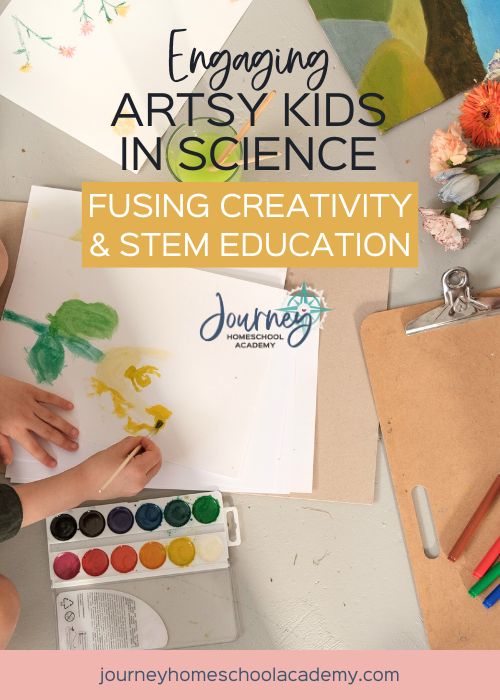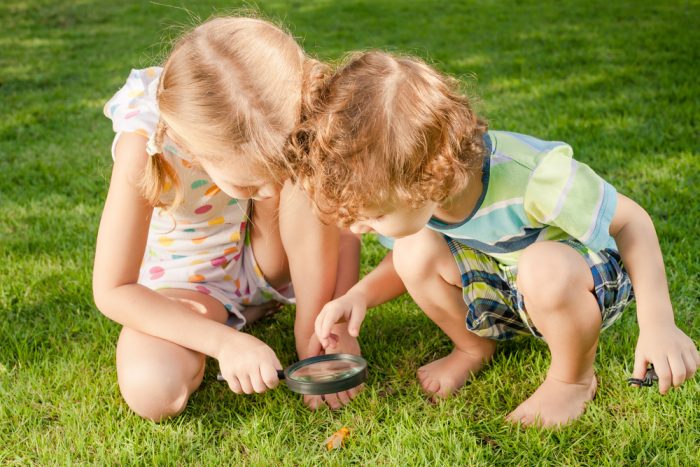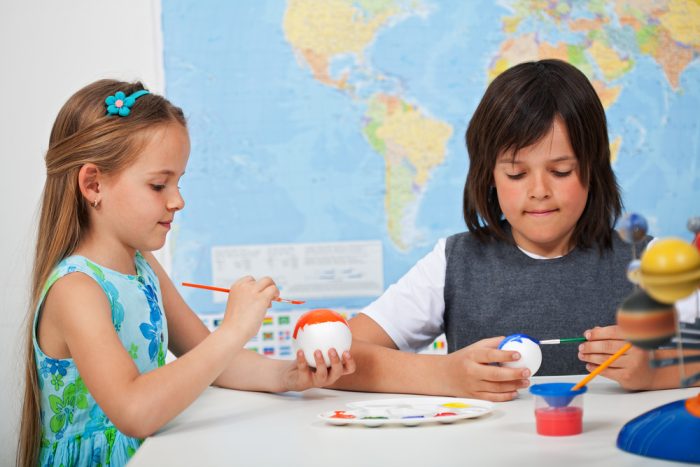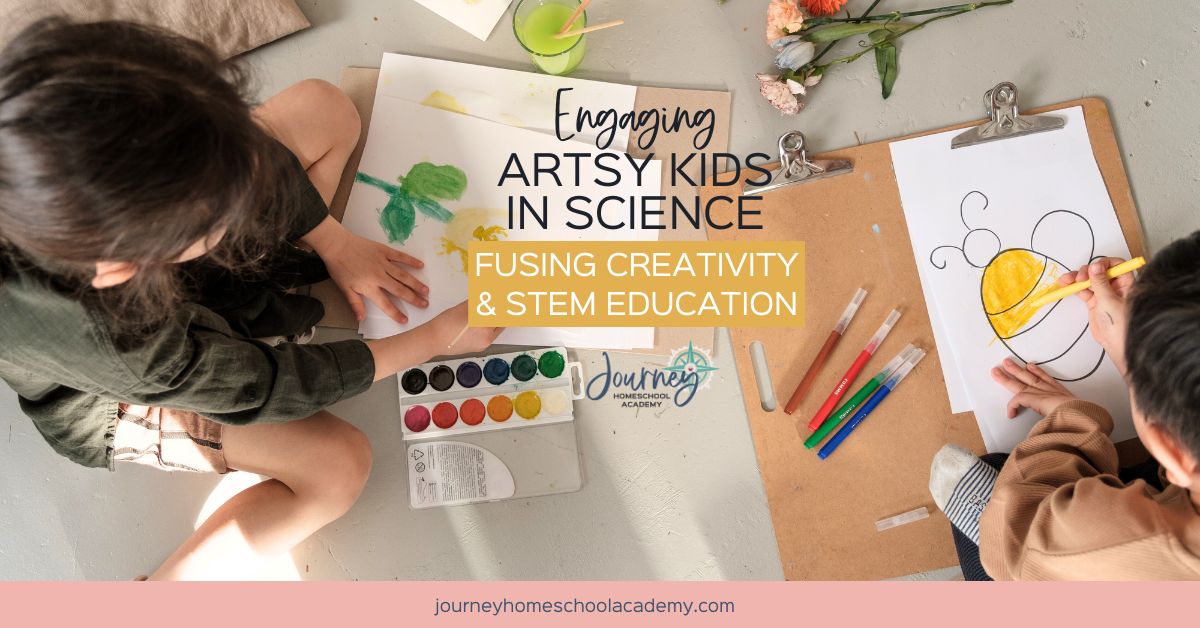My brother and I were opposites when it came to school. He could sit for hours and create beautiful pieces of artwork. I, on the other hand, preferred science experiments and answers to my many “why” questions. Since we were so close in age and did much of our school together, this created a challenge for my mom as she sought to tie together our individual loves for art and science. If you have an artistically inclined homeschooler, you’ve probably been in a similar boat! Inspiring interest for your artsy kids in science may seem daunting at first, but it can totally be done. Science, though full of facts and reading, also holds wonderful opportunities for hands-on learning that will interest even the most creative and imaginary mind (aka the artist!).

When working to interest your artsy kids in science, remember…
Homeschooling creates an avenue for flexible learning styles. If your student prefers hands-on learning, sitting in a lecture-style classroom from 9 a.m. to 3 p.m. each day won’t give them an outlet for their creativity and visual learning. For the artist in your home, this is a huge win for homeschooling! Sure, you may still need to take some time to read a textbook or study biology terms, but you can use the flexibility to incorporate their creativity into experiments, labs, and art projects like poster boards or diagrams.
Here are a few general suggestions to help engage your artsy kids in science. We’ll dive deeper into some actual examples too!
Increase the number of experiments/labs you do.
Kids who enjoy art tend to be visual learners. This means that the more experiments and labs you incorporate into daily learning, the better! Don’t worry, you don’t have to plan elaborate labs every single day (unless you really want to). Simple activities will encourage your student to be hands-on, satisfying their need for visual comprehension.
Utilize the outdoors as much as possible.

For some science topics, going outside might not be super helpful. But for many – biology, astronomy, earth science – the outdoors is exactly where you and your artsy kiddo should be! Some of my favorite homeschool memories involve grabbing a big blanket, sitting in the backyard, and observing and drawing the world around me. And that’s coming from someone who is NOT artistically minded!
A science sketch pad like this one gives your student the opportunity to both draw and write about the world around them. This combines art and science perfectly!
Rely less on writing and more on visual narration.
I loved writing narration papers, but my brother struggled with it. To encourage reading comprehension while still encouraging a love for art, utilize visual narration from time to time. The science sketch pad comes in handy once again; ask your student to draw a picture of what they learned from the textbook reading and describe the picture in one paragraph. The amount they write can increase or decrease based on their age.
Keep in mind that most colleges won’t cater to this style of narration; they’re going to want the essay regardless of learning style. If you have an artsy high school student, you can still encourage them in visual learning, but don’t be afraid to give them work that takes them out of their comfort zone.
Host a homeschool-style science fair!
Most public schools host science fairs where students put together a science experiment, theory, or scientific process and document it on a large poster board. You can do this too! Poster boards are inexpensive and can be found at office supply stores or popular retail stores. Let your student express their creativity on the poster through a specific topic like photosynthesis or the life cycle of a frog!
If you know other local homeschool families, encourage them to do the same, and then gather together and let each student present their poster! It will be so fun to see the artistic personality of each student on display through their poster.
Incorporate diagrams into testing.
Multiple choice is classic style for testing, but it can often be difficult for students who prefer visual learning over memorization. If your curriculum allows, incorporate a diagram into a quiz or test. For example: “Draw a flower and label as many parts as you can.” Alternatively, you can provide the diagram and leave blank spaces for labeling. Either way, providing that visual aspect will stimulate learning and memory retention.
Five Artsy STEM Activities to Get You Started

Without further ado, here are a few activities to help engage your artsy kids in science! Most can be used across many grade levels.
Trace the Human Body
One of my personal favorites as a kid, this activity gives your student a blank canvas for their artistic talent, while still incorporating learning through human anatomy!
Create a Habitat Diorama
This is another activity that really has no bounds when it comes to artistic expression. Have your child pick an animal or ecosystem (preferably one that you’ve been studying in science) and let their imagination and STEM concepts collide into one amazing diorama box.
Erupting Rainbow Sidewalk Chalk Paint
For little learners, this is a great beginner activity! First, they’ll get to express their artsy side through chalk paint. Then, hand them a spray bottle of vinegar and watch their minds be blown as their chalk paint “erupts” from the chemical reaction! This can lead into a very simple discussion about chemistry and why the paint reacted to the vinegar.

Styrofoam Solar System
With this kit and some paint supplies, encourage your student to create a miniature solar system! Give them some boundaries, such as painting each planet to look like the real ones. While the paint dries, you’ll have time to have a fruitful conversation about each planet and why your student chose to paint them like they did. If they can, have them label each one too.
Pressed Flower Pictures
First, your student will learn about botany as they head outside to collect flowers of all kinds. Then, they’ll get to express the artsy side of this activity as they press the flowers and use them to create a beautiful piece of art. It’s the best of both worlds (and something I still love to do as an adult!).

Making Science Fun (And Artsy) Again
At Journey Homeschool Academy, we have a passion for science and STEM concepts. It’s what drives us to create high-quality courses for your homeschooled students of all ages! However, we also fully understand that not every student is the same. Learning styles vary!
Because of this, we strive to integrate various learning styles into each of our courses. In addition to your typical textbook reading, we offer:
- Engaging videos
- Plenty of hands-on activities and experiments
- Flexible schedules
- Thorough reading lists with highly vetted books
- …and more!
Your art-loving student can love science, and we’re here to make that happen!
